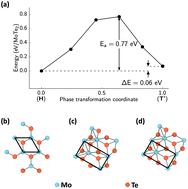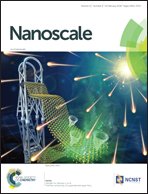Semiconductor–metal structural phase transformation in MoTe2 monolayers by electronic excitation†
Abstract
Optical modulation of the crystal structure and materials properties is an increasingly important technique for functionalization of two-dimensional and layered semiconductors, where traditional methods like chemical doping are ineffective. Controllable transformation between the semiconducting (H) and semimetallic (T′) polytypes of transition metal chalcogenide monolayers is of central importance to two-dimensional electronics, and thermally-driven and strain-driven examples of this phase transformation have been previously reported. However, the possibility of a H–T′ phase transformation driven by electronic or optical excitation is less explored and little is known about the potential energy surface and the magnitude of activation barriers or the mechanism of the phase transformation in the excited state. Here, we model the electronic and ionic structure of excited MoTe2 crystals and demonstrate how electronic excitation leads to a Fermi-surface-nesting driven softening of phonon modes at the Brillouin zone boundary and the subsequent stabilization of a low-energy intermediate crystal structure along the semiconductor–metal phase transition pathway. The significantly reduced barriers for this transformation upon electronic excitation suggest that optical excitation may enable rapid and controllable synthesis of lateral semiconductor–metal heterophase homojunctions in monolayer materials for use in next-generation two-dimensional nano-electronics applications.



 Please wait while we load your content...
Please wait while we load your content...